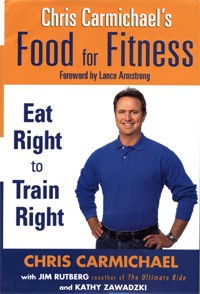Food For Fitness: Eat Right To Train Right
|

|
| Author: |
Carmichael C, Rutberg J, Zawadzki K |
| Category: |
Sports Nutrition |
| Audience: |
Elite Athlete |
| Length: |
414 pages |
| Publisher: |
G. P. Putnam's Sons |
| Year Published: |
2004 |
| List Price: |
$25.95 |
|
|
|
|
AthleteInMe.com®
Rating:



 Excellent!
Excellent!
Food for Fitness: Eat Right To Train Right is an excellent resource for serious cyclists, triathletes, and weekend warriors.
• Recommended for: All cyclists, triathletes, and weekend warriors.
ABOUT THE AUTHORS
• Chris Carmichael is best known as Lance Armstrong's trainer. (hopefully, you have heard of Lance Armstrong!...). In 1999, Carmichael founded Carmichael Training Systems (CTS) to bring quality coaching to elite athletes. 1999 was the first year that Lance Armstrong won the Tour de France, and, Carmichael was named the US Olympic Committee's Coach Of The Year. In the early 80's, Carmichael was an elite cyclist himself. He raced in the US and in Europe and was selected to the 1984 US Olympic cycling team. After the Los Angeles Olympics, Carmichael joined the 7-Eleven professional racing team. He has published several other books on cycling.
• Jim Rutberg, BS holds a BS in health and exercise science from Wake Forest University. He is a former elite cyclist who was coached by Chris Carmichael and now works at CTS. Rutberg also co-authored another Chris Carmichael book: The Ultimate Ride.
• Kathy Zawadzki is a certified sports nutritionist and a licensed cycling coach. While in graduate school, one of her research interests was the effect of carbohydrates and protein on recovery. She is a masters athlete and works at Carmichael Training Systems.
CONTENT
The 414-page book is organized as follows:
PART I: What It Means To Be An Athlete
- Chapter 1: Food For Fitness
- Chapter 2: Periodization: The Road Map to Optimal Performance
- Chapter 3: The Carmichael Nutrition Program
PART II: The Best Fuels For The Job
- Chapter 4: Making The Right Choices
- Chapter 5: An Athletes' Guide to Carbohydrates
- Chapter 6: Setting the Record Straight on Low-Carb Diets for Athletes
- Chapter 7: An Athlete's Guide to Protein
- Chapter 8: An Athlete's Guide to Fats
- Chapter 9: Vitamins and Minerals: Spark Plugs That Ignite Your Performance
- Chapter 10: For Best Results, Water Frequently
- Chapter 11: Fueling Up For Performance: Before, During, and After
PART III: Sports Nutrition From All Angles
- Chapter 12: The Young and Restless: The Adolescent Athlete
- Chapter 13: The Active Woman: What You Need to Know
- Chapter 14: Wisdom for Older Athletes
- Chapter 15: Eating on the Go
PART IV: Recipes, Training Programs, Meal Plans, and More
- Chapter 16: High-Octane Cooking
- Chapter 17: Sample Performance Meal Plans
REVIEW
One of the training principles Carmichael says he learned while coaching Lance Armstrong as he recovered from testicular cancer was not to push him to total exhaustion during a training session. It took Lance several days to recover.
So, Carmichael utilized a heart rate monitor and a power meter and maintained Armstrong's exercise intensity in the aerobic phase, and out of the higher anaerobic range. This allowed Armstrong to recover better and his aerobic fitness improved steadily.
From this experience, Carmichael learned how to fine-tune an aerobic athlete's nutrition system. In another example, he worked with a 275-lb NFL player who was consuming 12 chicken breasts per day, which worked out to 2.7 grams of protein per kg per day.....way more than any athlete needs. More importantly, this athlete wasn't consuming enough carbohydrates which his body desperately needed for immediate energy demands. Once Carmichael adjusted this athlete's carb-protein ratio (less protein, more carbs), this player had more energy and stamina during practices.
"Foundation-Preparation-Specialization-Transition"
One of the main principles of Carmichael's nutritional program is based around 4 phases he refers to as foundation, preparation, specialization, and transition. For each phase, he offers specific amounts and ratios of carbs, fats, and protein. The specific amounts are summarized clearly in the tables on pp. 35-37.
In general, I was highly impressed by this book. It is one of the easiest-to-read (and understand!) sports nutrition books I have come across. Nutrition principles are explained in plain English, and specific nutritional details are spelled out clearly in a multitude of tables throughout the book. You won't get bogged down with lots of biochemistry or scientific language. This book is just easy to read!
• What I Liked: Ummm....everything!
• What Could Be Better: In the fall of 2011, I spent 4 months reviewing research for my review Protein and Exercise. Robert Wolfe, PhD, provides convincing evidence that the RDA for protein is, and has been for a long time, too low. I looked in Carmichael's chapter on protein for his take on this concept. He didn't really address it. But, this analysis isn't really fair; some of Wolfe's papers were published after Food For Fitness had already been published.
SUMMARY
Food For Fitness: Eat Right To Train Right is an excellent sports nutrition resource for any and all aerobic athletes. I can recommend it without reservation.
| Reviewed by: Stan Reents, PharmD |
8/5/2015 8:40:19 AM |
|